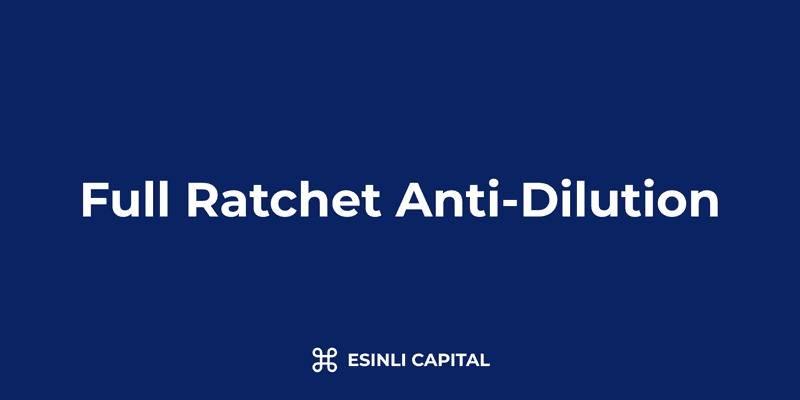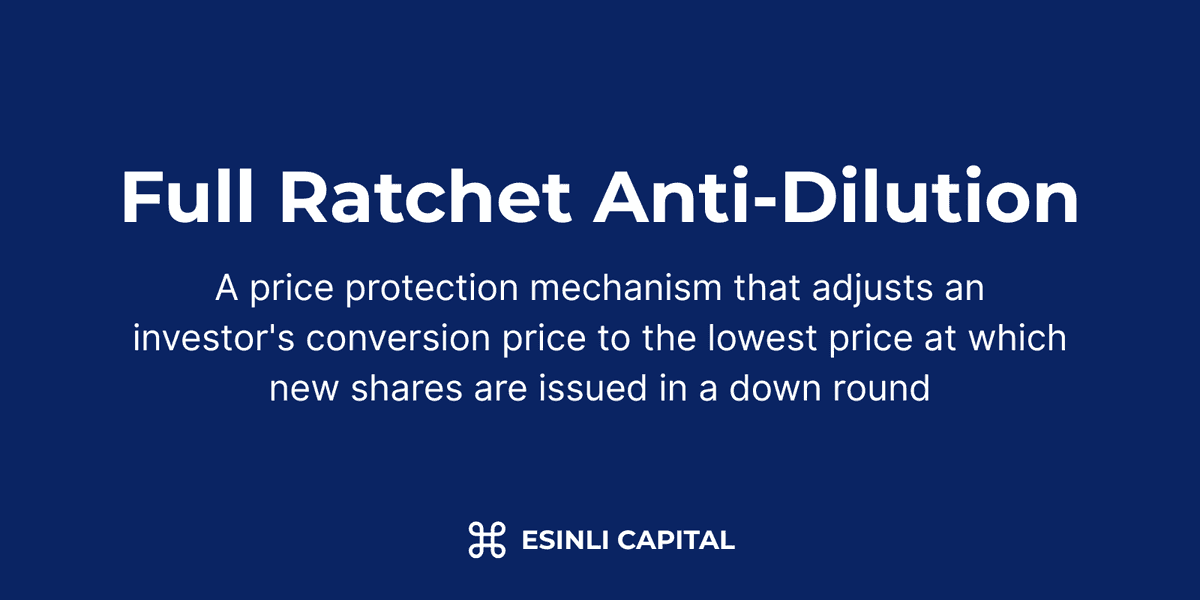In This Article
- What Is Full Ratchet Anti-Dilution?
- Full Ratchet Anti-Dilution's Impact on Founders and Companies
- Negotiating Full Ratchet Anti-Dilution Terms
- When Full Ratchet Anti-Dilution Is Triggered
- How to Avoid or Minimize Full Ratchet Anti-Dilution
- Full Ratchet Anti-Dilution Protection in Different Market Conditions
- Full Ratchet Anti-Dilution vs. Other Investor Protections
- Full Ratchet Anti-Dilution: Final Considerations and Recommendations
- What Is Full Ratchet Anti-Dilution?
- Full Ratchet Anti-Dilution's Impact on Founders and Companies
- Negotiating Full Ratchet Anti-Dilution Terms
- When Full Ratchet Anti-Dilution Is Triggered
- How to Avoid or Minimize Full Ratchet Anti-Dilution
- Full Ratchet Anti-Dilution Protection in Different Market Conditions
- Full Ratchet Anti-Dilution vs. Other Investor Protections
- Full Ratchet Anti-Dilution: Final Considerations and Recommendations

Full Ratchet Anti-Dilution: Mechanics, Founder Impact & Negotiation Strategies
KEY TAKEAWAYS
- Full ratchet anti-dilution is the most aggressive form of price protection for investors, adjusting their conversion price to match the lowest price of a down round.
- When triggered, full ratchet significantly dilutes common shareholders (typically founders and employees) while preserving investors' ownership percentage.
- Alternatives like weighted average anti-dilution offer more balanced protection and are more founder-friendly.
- Founders should negotiate anti-dilution carve-outs for specific situations and consider proposing pay-to-play provisions to offset harsh effects.
- Full ratchet terms are more common in buyer's markets or when companies have limited negotiating leverage.
What Is Full Ratchet Anti-Dilution?
Full ratchet anti-dilution is a price protection mechanism included in venture capital term sheets that protects earlier investors from dilution when a company raises capital at a lower valuation in subsequent financing rounds. It's the most aggressive form of anti-dilution protection, automatically adjusting an investor's conversion price to match the lowest price at which new shares are issued in a down round.
The term "full ratchet" comes from how the mechanism works: the conversion price of preferred shares "ratchets" down fully to the new, lower price, allowing investors to convert their preferred shares into a proportionally larger number of common shares. This effectively maintains the investor's percentage ownership while significantly diluting founders and other common shareholders.
How Full Ratchet Anti-Dilution Works
To understand full ratchet anti-dilution, let's break down its mechanics with a simplified example:
-
Initial Investment: An investor purchases 1 million Series A preferred shares at $1.00 per share ($1 million investment) with full ratchet anti-dilution rights. At this conversion price, these shares would convert into 1 million common shares, representing 20% ownership.
-
Down Round Occurs: The company later raises a Series B round at $0.50 per share (half the previous valuation).
-
Full Ratchet Triggered: The anti-dilution provision automatically adjusts the Series A investor's conversion price from $1.00 to $0.50.
-
Conversion Adjustment: Instead of converting to 1 million common shares, the Series A shares now convert to 2 million common shares (original investment ÷ new price = $1,000,000 ÷ $0.50 = 2,000,000 shares).
-
Ownership Reallocation: The Series A investor now effectively owns twice as many shares without investing additional capital, while founders and employees (common shareholders) see their ownership percentage significantly reduced.
The mathematical formula used for the full ratchet adjustment is straightforward:
Adjusted Conversion Price = Lowest Price of New Shares
New Common Share Equivalents = Original Investment ÷ Adjusted Conversion Price
This contrasts with weighted average anti-dilution formulas, which factor in the relative size of the down round compared to the company's overall capitalization.
Full Ratchet vs. Weighted Average Anti-Dilution
While both are anti-dilution mechanisms, full ratchet and weighted average protection differ significantly in their impact on stakeholders:
| Feature | Full Ratchet | Weighted Average |
|---|---|---|
| Calculation Method | Sets conversion price to lowest new share price | Blends original and new prices based on relative transaction size |
| Impact on Founders | Severe dilution | Moderate dilution |
| Fairness | Generally viewed as inequitable | Considered more balanced |
| Market Prevalence | Less common, seen in buyer's markets | More common, industry standard |
| Negotiability | Highly negotiable point | Often accepted as standard |
| Complexity | Simple calculation | More complex formula |
The weighted average method considers both the price and size of the down round relative to the company's existing capitalization. There are two variations:
- Broad-Based Weighted Average: Includes all outstanding shares on a fully-diluted basis (including options, warrants, and convertible securities)
- Narrow-Based Weighted Average: Considers a more limited subset of shares, making it more favorable to investors than broad-based but less severe than full ratchet
Full Ratchet Anti-Dilution's Impact on Founders and Companies
The implications of full ratchet provisions extend far beyond simple mathematical adjustments, creating significant consequences for founders, companies, and the overall fundraising ecosystem.
Founder Dilution
The most immediate and visible impact of full ratchet anti-dilution is the severe dilution of founder equity. When a down round triggers a full ratchet provision:
- Founders bear a disproportionate share of the dilution
- Employee option pools may need to be replenished, causing additional founder dilution
- The psychological impact of seeing ownership percentage significantly reduced can affect founder motivation
- Control dynamics within the company can shift as founder voting power decreases
For example, if founders initially owned 60% of a company and a full ratchet provision doubles the effective ownership of preferred shareholders in a down round, the founders' stake could be reduced to 30-40%, approaching or crossing critical control thresholds.
Company Decision-Making and Fundraising Strategy
Full ratchet provisions don't just sit dormant until a down round—they actively influence company decision-making:
-
Bridge Financing Preference: Companies may seek bridge loans or insider rounds to avoid triggering anti-dilution provisions.
-
Hesitation to Raise Capital: Even when additional capital would benefit the company, founders might delay fundraising if market conditions suggest a down round.
-
"Cram-Down" Round Risk: In severe cases, new investors may force a very low valuation (a "cram-down" round) to trigger full ratchet provisions, giving earlier investors substantial additional shares.
-
M&A Decision Impact: The dilution threat can push founders toward earlier acquisition rather than raising additional capital in challenging markets.
-
Convertible Note Strategy: Companies may opt for convertible notes with discounts rather than priced equity rounds to delay valuation determinations.
Long-Term Alignment Concerns
Perhaps most concerning is how full ratchet anti-dilution can misalign incentives among stakeholders:
- Existing investors might prefer a dramatic down round to trigger their anti-dilution protection
- Founders may make suboptimal business decisions to avoid a down round
- New investors might hesitate to invest if existing investors will receive substantial anti-dilution adjustments
According to a 2024 survey of venture capital terms, only 8% of venture deals included full ratchet provisions, compared to 84% with weighted average provisions, highlighting the market's general preference for more balanced approaches.
Negotiating Full Ratchet Anti-Dilution Terms
When faced with full ratchet anti-dilution terms in a term sheet, founders have several strategic options to consider:
Alternative Anti-Dilution Structures to Propose
-
Weighted Average Anti-Dilution: The most common alternative, calculating a weighted average of the old and new prices:
- Broad-based weighted average (includes all shares on a fully-diluted basis)
- Narrow-based weighted average (includes a more limited set of securities)
-
Partial Ratchet: A compromise approach where the conversion price adjusts to a percentage (e.g., 75%) of the way to the new price
-
No Anti-Dilution: While rare, some early-stage investments or founder-friendly investors might agree to no price-based anti-dilution
-
Time-Based Anti-Dilution Sunset: Provisions that reduce in strength or expire after a certain period (e.g., 3-5 years)
Anti-Dilution Carve-Outs to Negotiate
Even when accepting full ratchet provisions, founders can negotiate exceptions:
- Strategic Investor Carve-Out: Exclude lower-priced issuances to strategic partners
- Employee Stock Carve-Out: Exclude issuances to employees, consultants, or directors
- Minimum Threshold: Require the down round to be below a certain percentage (e.g., 20%) of the previous price before triggering
- De Minimis Exception: Exclude small issuances below a certain dollar amount or percentage of capitalization
- Pay-to-Play Requirements: Require participating in future rounds to maintain anti-dilution protection
Pay-to-Play Provisions as a Counter-Balance
A particularly effective counter to harsh anti-dilution terms is a pay-to-play provision:
- Requires investors to participate in future financing rounds proportionally to maintain their rights
- Investors who don't participate lose their anti-dilution protection
- Creates incentives for investors to continue supporting the company in difficult times
- Balances the protection with continued commitment
Market Standards and Negotiation Leverage
Whether full ratchet terms are reasonable depends heavily on market conditions and company-specific factors:
| Market/Company Condition | Typical Anti-Dilution Approach |
|---|---|
| Hot market, high-demand company | Broad-based weighted average or minimal anti-dilution |
| Standard market, stable company | Broad-based weighted average |
| Difficult market, early-stage company | Narrow-based weighted average |
| Distressed company, buyer's market | Full ratchet may appear |
| Bridge rounds or inside rounds | Often include stricter anti-dilution |
According to data from venture capital law firms, full ratchet provisions appear most frequently in:
- Seed rounds where investors have significant leverage
- Later-stage rounds for companies with questionable metrics
- Difficult fundraising environments where capital is scarce
When Full Ratchet Anti-Dilution Is Triggered
The mechanics of triggering and implementing full ratchet anti-dilution deserve special attention, as the details determine the actual impact.
Down Round Scenarios That Trigger Anti-Dilution
Full ratchet anti-dilution activates when a company issues equity at a price lower than previous rounds. Specific scenarios include:
- Subsequent Priced Rounds: The most straightforward trigger—a new equity round at a lower price per share
- Convertible Note Conversions: If notes convert at a discount to the price paid by new investors
- Warrant Exercises: If warrants allow purchase of shares at prices below previous rounds
- Option Pool Expansions: In some cases, significant increases in option pools can trigger anti-dilution
- Strategic Partnerships: Equity issued to partners at favorable valuations
Practical Implementation and Calculation Process
When a full ratchet provision is triggered, the implementation follows this process:
- Identification: The company or its legal counsel identifies that a triggering event has occurred
- Recalculation: The new conversion price is set to equal the lowest price of new shares
- Board Approval: The board formally approves the adjustment
- Notification: Investors are notified of the new conversion ratio
- Cap Table Update: The company's capitalization table is updated to reflect the new fully-diluted share calculations
- Certificate Amendment: The company may need to file amended certificates of incorporation or similar documents
Impact on Company Capitalization and Control
Beyond the mathematical adjustment, triggering anti-dilution provisions has cascading effects:
- Board Control: If board seats are tied to ownership percentages, control dynamics may shift
- Protective Provisions: Higher ownership percentages give preferred shareholders more blocking rights
- Future Fundraising: The capital structure becomes more complex and potentially less attractive to new investors
- Exit Mechanics: Liquidation preferences combined with increased ownership can dramatically change exit distributions
- Employee Option Pool: May require replenishment, causing additional dilution
Case Study: Full Ratchet in Action
To illustrate the real-world impact, consider this simplified case study:
Initial Round:
- Founders own 5 million shares (70%)
- Series A investors purchase 2.14 million shares at $1.40 each ($3M investment) with full ratchet protection (30%)
- Post-money valuation: $10 million
Down Round:
- Company raises $2 million at $0.70 per share (50% of previous round)
- Without anti-dilution: Series A would be diluted proportionally with founders
- With full ratchet: Series A conversion price adjusts from $1.40 to $0.70
- Series A effective share count doubles to 4.28 million shares
- Founders' ownership drops from 70% to approximately 50% (assuming new investors get 15%)
This dramatic redistribution of ownership occurs without any action from the Series A investors—purely through the mechanical application of the anti-dilution provision.
How to Avoid or Minimize Full Ratchet Anti-Dilution
For founders concerned about the potential impact of full ratchet provisions, several strategies can help avoid these terms or minimize their effect.
Fundraising Strategies to Avoid Down Rounds
The most effective way to neutralize anti-dilution provisions is to avoid triggering them:
-
Realistic Initial Valuations: Avoid inflated early valuations that will be difficult to increase in subsequent rounds
-
Adequate Runway Planning: Raise sufficient capital to reach meaningful milestones that justify higher valuations
-
Convertible Instruments: Consider seed financing through convertible notes, SAFEs, or other instruments that delay valuation determinations
-
Bridge Financing Options: Explore insider rounds, extension rounds, or venture debt when market conditions are unfavorable
-
Strategic Investments: Partner with strategic investors who may accept higher valuations based on strategic benefit rather than pure financial analysis
-
Revenue Focus: Prioritize revenue generation to reduce reliance on external financing
Legal and Structural Approaches to Minimize Impact
When anti-dilution provisions exist, several approaches can reduce their impact:
-
Anti-Dilution Waivers: In down round scenarios, negotiate with existing investors to waive their anti-dilution rights, possibly in exchange for other considerations
-
Recapitalization: In extreme cases, consider a complete recapitalization where all shareholders reset to a new structure
-
Voluntary Conversion: Some investors may agree to convert their preferred shares to common before a down round to simplify the capitalization structure
-
Separate Voting and Economic Rights: Structure deals to separate voting control from economic interests
-
Co-Sale Rights Modification: Adjust co-sale and tag-along rights to maintain founder liquidity options
Investor Relationship Management
Perhaps most importantly, maintaining strong investor relationships provides flexibility when challenging situations arise:
- Regular Communication: Keep investors informed about company progress and challenges
- Early Warning: Provide advance notice of potential financing needs
- Collaborative Problem-Solving: Involve key investors in developing financing strategies
- Mutual Success Focus: Emphasize shared interest in company success rather than zero-sum protection
According to a survey of venture capitalists, 65% reported waiving or modifying anti-dilution rights for portfolio companies they wanted to continue supporting, highlighting the importance of relationship over rigid enforcement of terms.
Full Ratchet Anti-Dilution Protection in Different Market Conditions
The prevalence and impact of full ratchet provisions vary significantly with market conditions and investment stages.
Historical Trends in Anti-Dilution Provisions
Anti-dilution terms have evolved with market cycles:
- Dot-com Era (1999-2001): Full ratchet provisions were common during the bubble, then caused massive founder dilution during the crash
- Post-Crash (2002-2006): The industry shifted toward weighted average provisions after seeing the harmful effects of full ratchet
- Financial Crisis (2008-2010): Temporary resurgence of full ratchet provisions in difficult fundraising environment
- Bull Market (2011-2021): Predominantly founder-friendly terms with broad-based weighted average standard
- Market Correction (2022-2024): Moderate shift toward investor-friendly terms, but full ratchet remained uncommon
Industry Differences in Anti-Dilution Standards
Different sectors show varying prevalence of strict anti-dilution terms:
- Life Sciences/Biotech: More likely to include stronger anti-dilution given high capital requirements and technical risk
- Enterprise SaaS: Typically uses standard weighted average provisions
- Consumer Tech: Often has the most founder-friendly terms with broad-based weighted average standard
- Hardware: Sometimes includes stronger protection due to capital intensity
- Frontier Tech (AI, Quantum, etc.): May include strong investor protections due to uncertain timelines
Regional Variations
Anti-dilution practices also vary by geography:
- Silicon Valley: Generally founder-friendly with broad-based weighted average standard
- New York: Slightly more investor-friendly terms but full ratchet remains rare
- Europe: More variation in terms, with stronger investor protections more common
- Asia: Often includes stronger investor protections including occasional full ratchet
- Emerging Markets: More likely to see full ratchet or narrow-based weighted average
Full Ratchet Anti-Dilution vs. Other Investor Protections
To fully understand the significance of full ratchet provisions, it's helpful to place them in the broader context of investor protection mechanisms.
Comprehensive Anti-Dilution Protection Spectrum
Anti-dilution protections exist on a spectrum from most founder-friendly to most investor-friendly:
- No Anti-Dilution: Investors receive no special protection against price declines
- Broad-Based Weighted Average: The most common standard, providing moderate protection
- Narrow-Based Weighted Average: Stronger investor protection by considering fewer shares in the formula
- Partial Ratchet: Conversion price adjusts partially toward the new price
- Full Ratchet: The most aggressive form, with complete adjustment to the lowest new price
- Multiple-Based Full Ratchet: Rare but extremely aggressive—adjusts to a multiple of the down round price
Anti-Dilution in Relation to Other Term Sheet Provisions
Anti-dilution provisions interact with other investor protections:
- Liquidation Preferences: Combined with anti-dilution, these can significantly impact founder economics in exits
- Participation Rights: Participating preferred stock plus anti-dilution can create extremely investor-favorable economics
- Protective Provisions: Veto rights combined with anti-dilution create strong investor control
- Pre-emptive Rights: These allow investors to maintain their percentage ownership through participation in future rounds
- Control Provisions: Board seats and voting rights can shift with ownership changes triggered by anti-dilution
Economic Analysis of Different Protection Mechanisms
The economic impact of different mechanisms reveals why full ratchet is considered aggressive:
| Anti-Dilution Type | 50% Down Round Impact on Founder Ownership | Relative Impact |
|---|---|---|
| No anti-dilution | Proportional dilution | 1.0x |
| Broad-based weighted average | Slightly higher than proportional | 1.2-1.5x |
| Narrow-based weighted average | Moderately higher than proportional | 1.5-1.8x |
| Full ratchet | Significantly higher than proportional | 2.0x+ |
When modeling outcomes, full ratchet provisions typically result in 30-50% more dilution to founders in a down round compared to broad-based weighted average provisions.
Full Ratchet Anti-Dilution: Final Considerations and Recommendations
As we've explored the complexities of full ratchet anti-dilution, several key recommendations emerge for founders, investors, and legal advisors.
For Founders Considering Term Sheets
-
Prioritize Anti-Dilution Negotiations: Treat anti-dilution terms as a critical negotiation point, not a standard provision
-
Understand the Long-Term Impact: Model potential down round scenarios to visualize the actual effect on your ownership
-
Consider Context: Evaluate the anti-dilution terms in relation to the overall term sheet—sometimes accepting stronger protection may be reasonable if other terms are favorable
-
Seek Balanced Protection: Propose broad-based weighted average as a fair middle ground that protects investors without severely punishing founders
-
Include Carve-Outs: If accepting full ratchet or strong protection, negotiate specific exceptions and sunset provisions
For Investors Structuring Deals
-
Balance Protection with Alignment: Consider how anti-dilution terms affect founder motivation and company success
-
Customize to Risk: Match the strength of protection to the specific risks of the investment rather than using a standard template
-
Consider Alternatives: Explore other mechanisms like liquidation preference multiples or board rights that might address concerns without harsh dilution effects
-
Add Pay-to-Play Requirements: Include provisions requiring continued support to maintain anti-dilution rights
-
Focus on Success, Not Protection: Remember that investor returns ultimately come from company success, not protective provisions
Best Practices for Anti-Dilution Implementation
When implementing any anti-dilution provisions:
-
Clear Documentation: Ensure the exact formula and triggering events are precisely documented
-
Regular Cap Table Reviews: Maintain updated capitalization models that show potential effects of provisions
-
Disclosure to All Stakeholders: Make sure key employees and other stakeholders understand the potential impact
-
Scenario Planning: Regularly model various financing scenarios to anticipate potential issues
-
Professional Guidance: Work with experienced venture capital attorneys who understand market standards
The Balancing Act of Investor Protection and Company Growth
Ultimately, the most successful venture relationships balance reasonable investor protections with founder incentives and company flexibility. The goal should be structural alignment where:
- Investors are protected from unfair dilution
- Founders maintain sufficient ownership to stay motivated
- The company retains flexibility to raise capital as needed
- All stakeholders benefit from company success
The trend toward weighted average provisions as the industry standard reflects this balanced approach, recognizing that excessive protection for any one stakeholder group ultimately undermines the shared goal of building valuable companies.
As one prominent venture capitalist noted, "The best investor protection isn't in the legal documents—it's in picking great founders and helping them build great companies."



